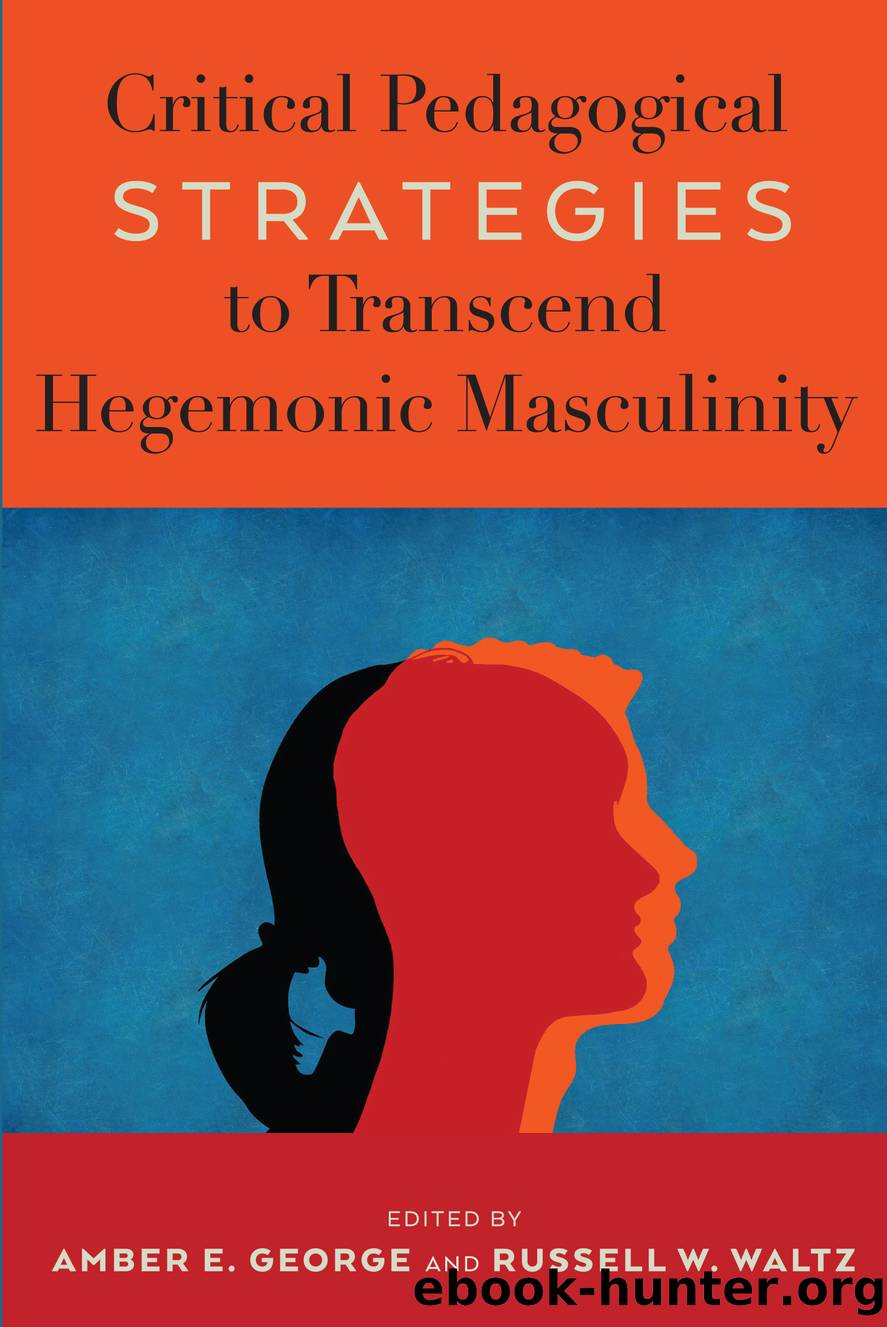Critical Pedagogical Strategies to Transcend Hegemonic Masculinity by E. George Amber / W. Waltz Russell

Author:E. George, Amber / W. Waltz, Russell
Language: eng
Format: epub
Publisher: Peter Lang Publishing, Inc
Lesson #4: Addressing Homophobia, Sexism, Transphobia, Misogyny in Media and the ClassroomâInclusivity as Pedagogical Praxis
The Women & Media class focuses on thoughtful media consumption, and the message is that the words, and by extension, the images, that we use matter in the representation of subjects, including the subject of oneâs ideology. The deliberate use of the phrase, âcis-, EuroAmerican, ableist, heteropatriarchyâ is intended to model the use of labels, and to serve as a continuous reminder of the attributes that are unlabeled, or âunmarkedâ in our culture as described in Anita Sarkeesianâs (2013) video, âFeminist Frequencyâs Tropes versus Women in Video Games,â which underscores the idea of gendered signifiers and what is marked, and what is not, in our culture. After watching the video, a class discussion ensues about marking misogyny and the male gaze. This discussion is often introduced in the online learning management system (Blackboard) first, so that participants can express their initial thoughts online after watching the video and then â110 | 111âcontinue the discussion in the face-to-face class. This way students can view the video, reflect a bit, then formulate their first thoughts before coming to class. This method also saves class time and ensures that everyone can respond to the video. The focus of the discussion starts with the use of the concepts âtropes,â âgendered signifiers,â and âlabelingâ and moves on to an exploration of the reaction that Sarkeesian received in connection with her Feminist Frequency videos (Rensin, 2015). This leads to another interrogation of the male gaze, and how labeling works to reinforce a set of norms within our culture, specifically, those of the cis-, EuroAmerican, ableist, heteropatriarchy to the detriment of those who do not fit into any or all those categories. The result is culturally-, religiously-, and linguistically-reinforced transphobia, homophobia, sexism, and misogyny as any combination of trans/fluid, non-EuroAmerican, differently-abled, and non-hetero (queer), non-patriarchal (but not necessarily matriarchal) prerogatives challenge the existing norms and bring into question the culturally- and religiously-held beliefs that have, over time, been linguistically inculcated. Individual studentsâ final projects might document the ways that the norms are reinforced within the culture and try to answer the question: How might the language and culture be different if these norms were not enforced so absolutely?
At some point in the class, the continued use of the phrase cis-, EuroAmerican, ableist, heteropatriarchy brings up the following question: Why are women so angry about the things we talk about in this class? The first time I was asked that question directly, it surprised me. I had been talking about the womenâs march on Washington after the 2016 election. We watched Ashley Juddâs (2014) âNasty Womanâ recitation on YouTube, and I had made a comment about it being an example of a counter-gaze to the cis-, EuroAmerican, ableist, heteropatriarchy because it is the statement of a clearly female point of view written by a poet who is speaking objection (if not truth) to power. Juddâs recitation is controversial because of its language, the subjects it touches on, and, for some, because it is presented in an angry female tone.
Download
This site does not store any files on its server. We only index and link to content provided by other sites. Please contact the content providers to delete copyright contents if any and email us, we'll remove relevant links or contents immediately.
The Art of Coaching Workbook by Elena Aguilar(48065)
Trainspotting by Irvine Welsh(20055)
Twilight of the Idols With the Antichrist and Ecce Homo by Friedrich Nietzsche(17706)
Fangirl by Rainbow Rowell(7834)
Periodization Training for Sports by Tudor Bompa(7328)
Change Your Questions, Change Your Life by Marilee Adams(6641)
This Is How You Lose Her by Junot Diaz(5773)
Grit by Angela Duckworth(4737)
Red Sparrow by Jason Matthews(4666)
Asking the Right Questions: A Guide to Critical Thinking by M. Neil Browne & Stuart M. Keeley(4576)
Paper Towns by Green John(4169)
Room 212 by Kate Stewart(4107)
Ken Follett - World without end by Ken Follett(3972)
The Sports Rules Book by Human Kinetics(3588)
Housekeeping by Marilynne Robinson(3401)
The Motorcycle Diaries by Ernesto Che Guevara(3332)
Introduction to Kinesiology by Shirl J. Hoffman(3301)
Exercise Technique Manual for Resistance Training by National Strength & Conditioning Association(3292)
Double Down (Diary of a Wimpy Kid Book 11) by Jeff Kinney(3272)
